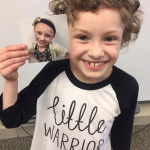Conjoined Twins Carmen Andrade Marries Longtime Boyfriend Daniel McCormack

A moving story of life, love, and the extraordinary journey of Carmen and Lupita Andrade
Carmen and Lupita Andrade, a pair of conjoined twins who share one body but live as two completely distinct individuals, have captured global attention for years. Their openness about daily life, identity, and independence has made them an inspiring presence on social media. In 2024, their story reached an emotional milestone when Carmen married her longtime boyfriend, Daniel McCormack.
Behind that unique wedding is a lifetime of resilience, adaptation, and unwavering acceptance of the bodies and the bond they were born into.
Carmen and Lupita, now 23, were born in Mexico and moved to the United States at age two. They are dicephalic parapagus twins — one of the rarest forms of conjoined twinning. This means they each have their own head and spine, but their bodies merge from the chest downward. They share many vital organs, including the lower digestive system, reproductive system, and circulatory system.
Despite their unusual anatomy, they have lived with remarkable coordination, humor, and strength — and have never once wished to be separated.
Two minds, one body — but two completely individual lives
Throughout their lives, Carmen and Lupita have faced countless intrusive questions from strangers. To address the curiosity, they created a candid Q&A video on TikTok, openly explaining how daily life works when two people share one body.
Carmen explains that, although they share many organs, they have two separate brains — which means two separate personalities, needs, and emotional worlds.
“We are two different people,” she said. “One of us can be tired while the other is fully awake. One of us can be sad while the other is completely fine.”
Their daily coordination is something they mastered naturally as children. Each twin controls one leg, so walking requires synchronized rhythm. Driving, however, falls mostly to Carmen — simply because she controls their shared right leg.
She joked in the video, “I have the right leg, so I’m the one who drives.”
Even mundane tasks like eating or sleeping are independent experiences. They share blood circulation but have separate stomachs, so hunger arrives at different times for each sister. Carmen may crave food while Lupita feels full, and they simply adjust. Sleeping patterns differ as well: one may be up late on her phone while the other drifts off easily.
Their life is a constant, beautifully coordinated conversation between two identities in one physical form.

What happens with alcohol, illness, or pain?
One of the most common questions they receive involves drinking. If one twin has alcohol, does the other feel it?
“Yes,” Carmen answers simply. “Because we share the same bloodstream.”
But because they have separate stomachs, one can eat a full meal while the other eats nothing at all. Their shared organs create a blend of mutual impact and personal independence that few people on Earth will ever experience.
Health issues are a real and significant concern. Both are at risk of developing sepsis — a bloodstream infection that could threaten their lives within hours. Because they share circulation, if one develops sepsis, both are in critical danger.
Still, Carmen dislikes being defined by fear or fragility.
“We don’t die,” she said sharply in the video. “So why does everyone ask us about death?”
Their story is not a tragedy — it’s a portrait of survival and self-determination.
Carmen and Daniel: A unique love story that is still completely normal
Carmen met Daniel several years ago, and they quietly built a strong, supportive relationship. She often emphasizes one point:
“He’s dating me — not Lupita.”
Lupita identifies as asexual and has no interest in romantic relationships. Surprisingly, she and Daniel get along extremely well. On nights when Daniel stays over, it’s not unusual for Lupita and Daniel to stay up late talking while Carmen falls asleep first.
Carmen says she finds this dynamic comforting, not strange.
“There’s no awkwardness,” she explains. “Daniel understands who we are. He loves me, but he also respects Lupita as a person.”
The couple’s intimate relationship, including their physical closeness, is naturally complex. Because they share reproductive organs and both have endometriosis, intimacy requires sensitivity and communication. Carmen has always spoken respectfully and carefully about this topic, making only one clear point: it is private, but it is real.
They have also confirmed that they cannot have children — and they do not want them. Carmen explains:
“We can’t have kids, and we’re fine with that. Daniel feels the same, so there’s no pressure.”
Their bond is built on communication, acceptance, and a deep understanding of each other’s limits.

Why separation is impossible — and unnecessary
While many people assume conjoined twins dream of surgical separation, the Andrade sisters have never wanted it. In their case, it is medically impossible. They share too many essential organs — and even if separation were attempted, the chances of survival for either sister would be near zero.
But beyond medical reasons, they are emotionally united in their decision.
Lupita once said:
“We were born this way. We live this way. We don’t know what separation feels like, so there is nothing to miss.”
They create personal space in their own ways. If one wants quiet time, she puts on headphones, reads, or scrolls through her phone while the other focuses on schoolwork or hobbies. Their closeness does not erase their independence — instead, it strengthens it.
What are conjoined twins?
Conjoined twins form when a single embryo fails to fully separate during early development. Depending on where they are connected, they may share organs, limbs, or other structures. Many conjoined twins do not survive long after birth, especially when vital organs are involved.
Carmen and Lupita’s form — dicephalic parapagus — is among the rarest and most dangerous. Most infants with this condition die shortly after birth because they cannot breathe or feed properly.
The twins’ survival into adulthood is medically extraordinary. Their ability to walk, study, socialize, and build lives is nothing short of remarkable.

Growing up, building a life, and finding joy
Despite the physical challenges they face, the twins have lived full, active lives. They attend school, make friends, go out, and share their experiences online. Their TikTok videos have earned millions of views, not because of shock value, but because of their humor and authenticity.
They don’t see themselves as inspirational — they simply live, adapt, and laugh.
“We never get tired of each other,” Carmen says. “If we want space, we just do our own thing.”
Their bond is rooted in deep mutual respect. They are sisters, but also partners in survival, each trusting the other to navigate the world with grace.
A wedding that marked not just love, but a shared victory
When Carmen married Daniel, the ceremony symbolized more than romance. It was a celebration of autonomy — Carmen choosing her own path, with Lupita by her side as she always has been.
In their wedding photos, Lupita stands next to Carmen not as an accessory, but as an equal presence: a sister witnessing a new chapter, a lifelong companion supporting the woman she shares her life with.
It was a wedding unlike any other — one bride, one groom, one shared body, and two hearts standing together as Carmen said “I do.”
They showed the world that love can exist beyond physical limitations, beyond expectations, and beyond what people believe is “normal.”
Their story is a reminder that happiness does not follow a traditional shape. It is something people define for themselves.











